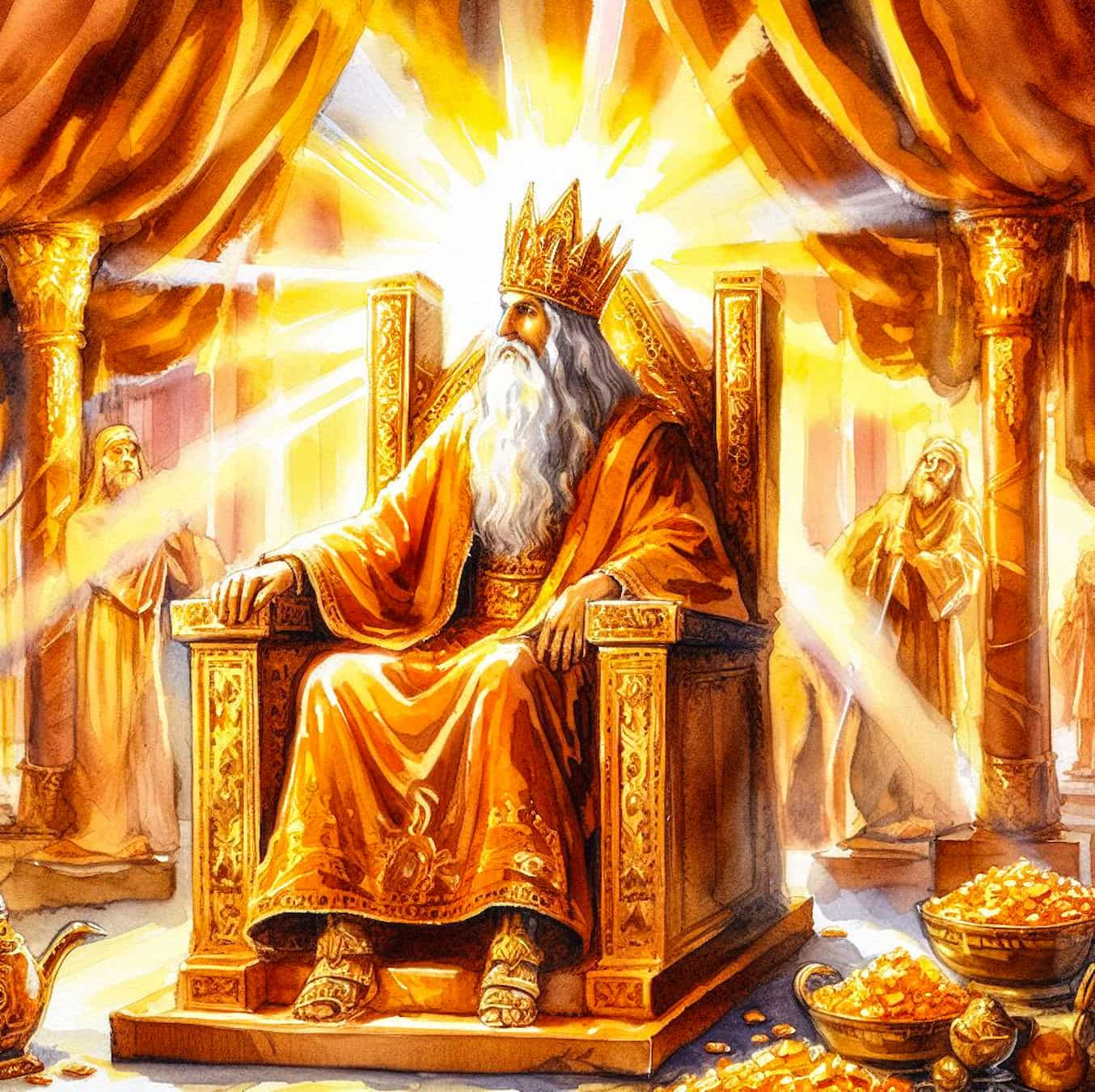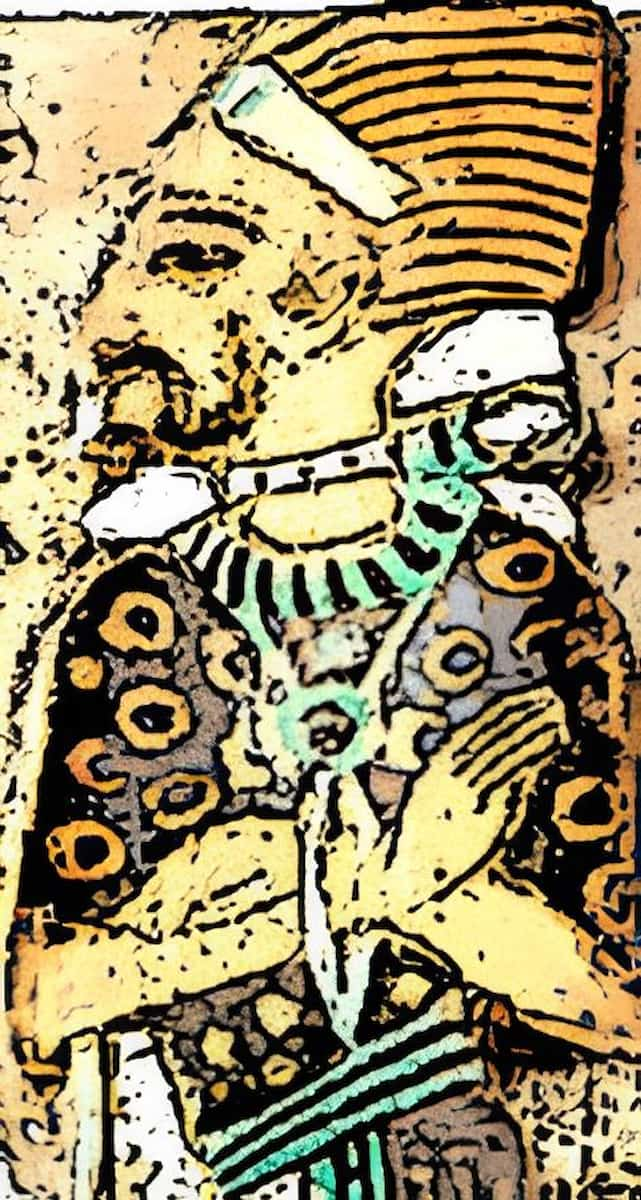- King Solomon’s annual income from gold was $1.5 billion.
- His powerful army included 10,000 horses and 3,000 chariots.
- Solomon’s lavish palace featured pure gold utensils and opulent decorations.
- No archaeological evidence supports Solomon’s legendary riches.
Israel’s King Solomon was a powerful and wealthy monarch. God endowed Solomon with knowledge, and the Bible portrays his reign as a time of extraordinary wealth. Estimates of his net worth range from $2 billion to $2.3 trillion. However, the median estimates put Solomon’s wealth at roughly $170 billion. The biblical king amassed 500 tons of gold from his mines, which translates roughly to $30 billion today. By monopolizing the major trade routes passing through Israel, Solomon amassed vast tax revenues.
-> See also: Shulamite: Solomon’s Bride, Her Origin and Meaning
How Did King Solomon Become So Wealthy?
Solomon received $60 billion in gold alone during his lifetime.
- The Kingdom of Israel was a significant trading center connecting Africa, Arabia, and Europe.
- Solomon’s fortified city was located on a busy trade route between prosperous civilizations. Merchants and travelers passing through the city had to pay a fee for passage, which was a significant source of income for his kingdom.
- He also had a close alliance with the Phoenician city-state of Tyre, which provided him with access to trade goods.
- He married the daughters of kings from neighboring kingdoms, which brought dowries and facilitated trade deals and his fame and reputation came from his belief in the rule of law.
- Solomon had control over highly productive mines, possibly copper mines, located far away and accessible through a long sea voyage.
Solomon’s Acquisition of Wealth
25 Tons of Gold Every Year

According to the Bible, Solomon’s annual base revenues were 50,000 pounds of gold. If we assume that the current value of a pound of gold is $30,000, then Solomon’s annual income from gold alone was about $1.5 billion in today’s money.
Therefore, in addition to the taxes paid by merchants, the profits from trade, and the tribute paid by the Arabian kings and the governors of the Israelite districts, King Solomon annually received over twenty-five tons of gold.
Since he inherited a strong monarchy and reigned for 40 years, this means that Solomon did $60 billion during his lifetime solely from annual gold payments. This wealth did not include other precious gifts he received from various nations.
-> See also: How Old Was Solomon When He Became King?
Taxes
34 tons of gold were brought to Solomon’s kingdom from Ophir.
Solomon restructured his kingdom into 12 districts that crossed ethnic lines in order to concentrate authority in Jerusalem. He maintained his father’s habit of marrying women from a wide variety of tribes and countries with whom he had alliances in order to appease the local populace.
During his reign, Solomon taxed his people heavily. However, he also amassed a fortune through the collection of taxes and customs from traveling caravans.
The Bible records (in I Kings, chapters 4–10) that 1,086 talents, or roughly 34 tons of gold, were brought to Jerusalem from Ophir (a port or region) by Solomon’s workers. About half of the ancient world’s known gold supply was thought to have been this amount in Solomon’s time. 34 tons of gold is equivalent to about $2 billion at today’s prices.
For comparison, in Old Testament times (2000–400 BC), one talent was worth around twenty years of average payment.
In addition to the taxes paid by merchants and traders, King Solomon also annually received over 25 tons of gold or 666 talents (a talent is about 75 pounds). There was also tribute paid by the Arabian kings and the governors of the Israelite districts.
Precious metals were measured in talents throughout Solomon’s reign, and this was also the standard unit of currency. A talent, or 75 pounds, was also a unit of currency used throughout the New Testament era (10 BC–100 AD) with an approximate value of $1,000 to $30,000. At today’s prices, 666 talents of gold is worth almost $1.5 billion.

Mines
Solomon supposedly amassed 500 tons of gold from the mines.
A victorious military campaign contributed to his rise to money and power. However, the mining of copper, iron, and gold also contributed to King Solomon’s net worth. Solomon mined gold from a location known as Ophir.
Hiram, king of the Phoenicians, dispatched his ships to Ophir in pursuit of this gold after forming an alliance with David and his son Solomon. Solomon received around 16 tons of gold from these ships. The commerce ships sailed often to Ophir and other destinations, returning once every three years with precious metals, animal parts, and other goods.
The Bible claims that King Solomon had around $2.3 trillion stashed away in his gold mines. The biblical king supposedly amassed 500 tons of gold from the mines.
On the other hand, there are many who believe that King Solomon of the Old Testament was really an Egyptian pharaoh and that his tale has been misconstrued.
Another major contributor to King Solomon’s riches was his ownership of the Timna copper mines in Israel. One of these ancient mines is still called Mikhrot Shelomo ha-Melekh (“King Solomon’s Mines”). This specific mine is about 1,000 feet long and more than 425 feet wide.
Trade
In addition to building the first temple in Jerusalem and running a kingdom, Solomon amassed vast wealth through his dominance of the spice trade.
The international trade activities of King Solomon contributed greatly to his wealth. Solomon formed trade alliances with states like Tyre and Egypt, and every three years, his fleets would return with precious cargo like gold, silver, and ivory, as well as peacocks and apes.
Direct economic benefits resulted from the expansion of his kingdom from the Euphrates to the Egyptian border. The spice market played a key role in Solomon’s enormous net worth. He was there to greet Queen Sheba of South Arabia when she arrived in Jerusalem, “bearing spices” on camels, along with gems.

There was a thriving spice trade in the area, with the Arabian Peninsula serving as a major export hub for all manner of aromatic resins, incense, and medicinal brews. Historically, the Eastern World was a major trading partner for Westerners interested in spices like nutmeg, ginger, cinnamon, clove, cardamom, star anise, turmeric, cassia, and pepper.
Almost a thousand years before the start of the Christian era, some of these spices made their way to the region controlled by King Solomon. Solomon controlled the market for the ancient world’s most precious commodities: frankincense and myrrh.
Free Labor
Around 150,000 forced laborers were ready to serve.
30,000 men made up Solomon’s levy of workers. 10,000 were dispatched to Lebanon in shifts, each working there for a month before returning home for two. Adoniram, Solomon’s tax collector who oversaw the system of forced labor, was in charge of this lucrative business.
Cedar wood was a kind of timber that many ancient cultures placed a high monetary value and symbolic importance on.
For the construction of the Temple, Solomon sent a work force of some 30,000 men to Hiram’s forests in Lebanon to harvest cedar and cypress trees.
He also had 3,300 managers and supervisors overseeing a labor force of 70,000 people who carried loads and another 80,000 who mined stone in the highlands.
Solomon employed this workforce to construct the city wall and fill in land on the east side of the city, in addition to constructing the temple and his palace practically for free labor. Hazor, Megiddo, and Gezer were all reestablished thanks to his forced workers.
However, it appears that Solomon compensated the Israelites who were conscripted to work while he was king. This was in accordance with the prohibition against making Israelites into slaves found in Leviticus 25:44–46.
Examples of How Rich Was King Solomon
He was able to build grand structures, keep a strong army, and build and maintain an extravagant palace through his riches.
King Solomon’s Golden Palace

Solomon used his riches to many different uses. The gold used to construct King Solomon’s palace was the real deal. The Bible portrays it as a gorgeous building, complete with an ivory throne covered in pure gold.
The pure gold lampstands, flowers, tongs, bowls, pans, and dishes for carrying coals, the gold hinges for the doors, and the outer court were all items that Solomon specifically commanded to be made from gold for his palace, which took him 13 years to build.
His cups were made of gold, and he had 300 bucklers and 200 massive shields made of gold alloy at his disposal.
The Temple of the Lord

The most prominent use of Solomon’s wealth was in the construction of the Temple of Jehovah (God/Lord) in Jerusalem. He organized a “donation drive” that raised almost $120 million in modern money. He spent 5,000 gold talents and 10,000 silver talents to build the temple. Gold paneling, containers, pillars, jewel-encrusted courtyards, silver, spices, animals, fabrics, bronze, cedars, etc., adorned this structure, also known as the First Temple.
The oracle altar and the floor of the Temple of the Lord were both covered in gold. Everything within the house, including the 15-foot-tall cherubs in the Most Holy and the altar of incense, was covered in gold. Gold leaf covered the cherubic figures, palm trees, and open flowers that adorned the structure’s walls. King Solomon’s great wealth was on full display.

This was a biblical temple in Jerusalem that dates back to the 10th–6th century BC and goes by several other names. Designed as a shrine to God and a permanent residence for the Ark of the Covenant, it was commissioned by King Solomon. During the 587 BC Siege of Jerusalem, Nebuchadnezzar II of the Neo-Babylonian Empire ordered the temple to be destroyed (2 Kings 25:8-9).
When Nebuchadnezzar’s soldiers pillaged the First Temple, the money they made helped keep the Babylonian Empire going, and then the Persian Medes absorbed Babylonia and used this wealth to expand their own empire.
Second Temple
For comparison, according to the value of stonework, labor, money, silver, incense, oils, annual revenue, and land, the Second Temple’s treasury would be worth nearly a trillion dollars by today’s standards. This temple was built in 516 BC, around 500 years later.
Historians justify the value of the Second Temple by associating it with the restoration of Roman power after the destruction of the temple in 68–70 AD. It was built at a fraction of the cost of the First Temple, despite its larger size. Because much less gold and more stone were present in the structure.
His 10,000 Horsemen and 3,000 Chariots
According to the Bible, King Solomon had a powerful army that included thousands of chariots and horsemen.
Solomon’s armies had around 10,000 horses and 3,000 chariots. Archaeologists at Megiddo have uncovered two royal stable complexes with stalls for 480 horses.
According to the Bible (1 Kings 9:15–19), he strengthened the defenses of Megiddo, Hazor, and Gezer because of their strategic locations and importance as chariot bases.
Solomon lived around 970–930 BC, and owning a single ancient Egyptian chariot in 1500 BC cost around 23 troy ounces of silver. For comparison, a Roman Legionnaire in 14 AD was paid around 32 troy ounces a year. Now add the cost of horses and the cost of maintaining them to this equation.
Imagine Having 700 Wives
Solomon lavished his many wives and concubines with extravagant palaces. It is said that King Solomon had a harem consisting of 700 wives and 300 concubines. The daughter of Pharaoh, women from Moab, Ammon, Edom, Sidon, and the Hittites were among the described wives. Although historical texts are vague on the subject, it’s assumed that he constructed lavish palaces for his many wives and concubines, similar to what Genghis Khan also did for his wives.
Extravagant Presents
The Bible portrays King Solomon as a wise and righteous leader who was beloved by his people; one of the reasons for his popularity was his lavish giving. He was quite generous with his money, and he was famous for lavishly rewarding his staff.
When the wealthy king was visited by the Queen of Sheba, she saw the elaborate feasts Solomon hosted and the elaborate sacrifices he made at the Temple, as well as the food he ate, the living quarters his officials occupied, the structure of his palace staff and the uniforms they wore.
Because she was so amazed by Solomon and all he had accomplished with “God’s aid”, the queen of Sheba presented him with 120 talents of gold, the equivalent of more than $48,000,000 at the time.
Utensils Made of Pure Gold
Solomon’s palace was one of the most opulent in history. The fine gold that adorned his throne set it apart as fit for a king. Everything in the House of the Forest of Lebanon, including his goblets and other utensils, was made of pure gold. This building likely served as the king’s palace’s main entrance in Jerusalem.
No silver was used in any of the utensils stored in his palace. In Solomon’s time, silver was not used for anything due to its low value. This exemplifies the richness of the kingdom under King Solomon. Solomon’s personal goldsmiths were the Tawils, who hailed from the city of Azech in Tur Abdin (present-day Turkey).
The throne had six steps leading up to it, and its back was rounded. Two lions stood at attention between the arms on each side of the throne. And there were twelve lions, six on each side, guarding the six stairs. Not a single kingdom produced something like.
Other Kings Who Also Possessed Immense Wealth in Gold
- The Egyptian temple of Amun-Ra at Karnak was gifted around 13.5 tons of gold by King Thutmose III in the second millennium BC.
- Solomon’s temple covered in gold wasn’t out of the ordinary in antiquity. The Egyptian pharaoh Amenophis III built a temple covered with gold to the deity Amun at Thebes. There were gold-plated fixtures, a silver-paved floor, and electrum inlay on all doors and windows.
- In the seventh century BC, Assyrian king Esarhaddon had gold applied on the walls and doors of the Ashur shrine. Nabonidus of Babylon (6th century BC), when asked about the temple of Sin at Harran, said, “I covered its inside with gold and silver and polished it till it gleamed like the sun.”
- Inscriptions from ancient Egypt reveal that King Osorkon I (early 1st century BC), gave the gods a total of around 383 tons of gold and silver.
- More than 37 tons of gold were extracted annually from the Pangaion mines in Thrace under King Philip II (359–336 BC).
- Alexander the Great (336-323 BC), Philip’s son, conquered the Persian city of Susa and looted its wealth, which included more than a thousand tons of gold.
-> See also: Was King Solomon Black? Accounts and References
Doubts About Solomon’s Net Worth

There is no proof that Solomon’s Temple or the legendary kings David and Solomon ever existed. There are no historical records of such mighty rulers, so these people, after all, must be allegories. There is no archaeological evidence of the residences or reigns of the people described in the Bible as living in Solomon’s rich kingdom.
According to archaeological estimates, there were only around 6,000 people living in Judah in the tenth century BC, with about 2,000 of them residing in Jerusalem. No monarch could ever collect enough tax revenue from so few subjects to maintain the lavish lifestyle portrayed in the Bible. Neither could he have mustered a force strong enough to plunder the prosperous western city-states.
According to the Bible, King Solomon erected fortified walls around his capital city of Jerusalem, just like those in Megiddo, Hazor, and Gezer. He also built an extravagant palace for himself. According to legend, he led a massive army consisting of 40,000 horsemen and charioteers and was so wise and wealthy that he was considered the greatest king in history.
These assertions portrayed Israel’s Golden Age, a time of rapid recovery from military setbacks and the establishment of a prosperous empire. Archaeological discoveries, however, cast doubt on such accounts. Studies conducted in the 1960s uncovered a palace beneath the alleged stables, indicating that the buildings were likely not built by Solomon but rather by King Ahab, the seventh king of Israel.
Subsequent excavations in the 1970s and 1980s revealed only fragments of pottery dating back to the 10th century BC and no evidence of Solomon’s purported golden palace or temple. For Israeli archaeologist Prof. Israel Finkelstein, there has been no discovery of Solomon’s Temple in Jerusalem.
This casts doubts about Solomon’s net worth and his status as a rich king in history.






